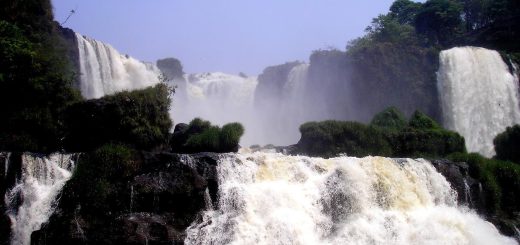Guaira Falls – A Lost Natural Wonder
Deep within the heart of South America, on the border between Paraguay and Brazil, a magnificent spectacle once graced the Paraná River – the Guaira Falls. Known as “Saltos del Guaira” in Spanish and “Salto das Sete Quedas do Guaira” in Portuguese, these falls were a breathtaking series of immense waterfalls that captivated all who beheld them. Today, we embark on a journey to discover the history, grandeur, and ultimately, the sorrowful submergence of the Guaira Falls.
Table of Contents
The Unparalleled Beauty of Guaira Falls
The Guaira Falls were unlike any other natural wonder on Earth. Their majesty was a result of the Paraná River’s journey through a narrow gorge, forcing it to squeeze from a width of approximately 380 meters down to just 60 meters. This natural constriction gave rise to a series of 18 cascading cataracts, clustered into seven groups, hence the name “Sete Quedas,” which translates to “Seven Falls” in Portuguese. The combined height of these falls reached a staggering 114 meters, with the tallest single cataract plummeting 40 meters. The roar of the tumbling water could be heard from a distance of up to 30 kilometers, a testament to the falls’ awe-inspiring power.
The Rise and Fall of Guaira Falls
Guaira Falls were not only a geographical wonder but also a symbol of international cooperation. Prior to their submergence, both Brazil and Paraguay claimed ownership of the falls. However, in 1973, a bilateral agreement was reached, authorizing the construction of the Itaipu Dam. This monumental undertaking marked a new era of collaboration between the two nations.
As the dam’s construction advanced, thousands of visitors flocked to Guaira Falls, knowing that their days were numbered. Tragically, on January 17, 1982, disaster struck when a suspended footbridge collapsed, claiming the lives of numerous tourists. This heart-wrenching event cast a shadow over the impending loss of this natural wonder.
Carlos Drummond de Andrade’s Lament
Renowned Brazilian poet Carlos Drummond de Andrade captured the collective sorrow over the destruction of Guaira Falls in his poignant poem, “Farewell to Seven Falls.” In it, he expressed dismay at the transformation of a once-pristine natural wonder into a cold, corporate endeavor. His words, printed in large type in the Jornal do Brasil newspaper, resonated with many who mourned the falls’ impending submergence.
The Submergence of Guaira Falls
The final days of Guaira Falls were marked by a demonstration as hundreds gathered to participate in a guarup, an indigenous ritual, in memory of the falls. The process of inundation was swift, taking only 14 days, aided by the high water levels of the Paraná River during the rainy season. By October 27, 1982, the falls had vanished entirely, with only a portion of the rock face occasionally visible during periods of drought.
In an attempt to mitigate the loss, the director of the company behind the dam construction argued that they were not destroying Guaira Falls but rather transferring its beauty to the Itaipu Dam, whose spillway would serve as a substitute for the falls’ grandeur.
Conclusion
The Guaira Falls, once a testament to the power and beauty of nature, now exist only in the memories of those who were fortunate enough to witness them before their submergence. As we reflect on their tragic demise, we remember the words of Carlos Drummond de Andrade and the collective loss of a natural wonder that will forever be etched in the annals of history. Guaira Falls, a symbol of cooperation and wonder, will forever hold a place in our hearts as one of the greatest treasures lost to time.
